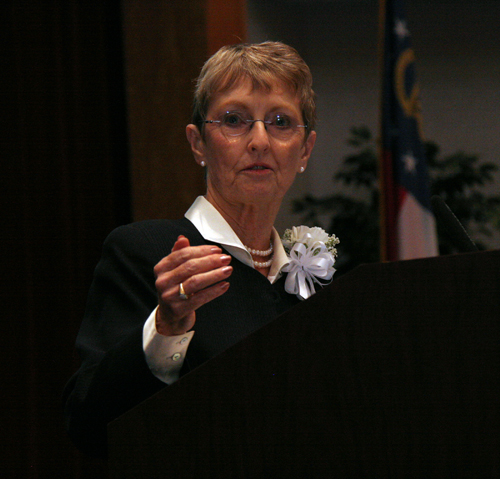Jean Kinsey suggested her 2010 D.W. Brooks Lecture might well have been titled “A Tale of Two Food Cultures.” Her talk this week in Athens, Ga., on “Feeding Billions: Local Solutions or Global Distributions” concluded that sustainably feeding the world will require both.
The annual lecture honors Brooks, the late founder of Gold Kist and Cotton States Insurance cooperatives and a University of Georgia graduate.
“I’m struck by the need to reduce hunger, increase food production, increase sustainability and reduce transportation to deliver food,” said Kinsey, a professor of applied economics at the University of Minnesota and former director of the university’s Food Industry Center.
“In a parallel universe, there are those who would say, ‘we should only eat food that was produced locally.’ Those in that camp often say that food also should be organic, animals should be treated kindly and plants shouldn’t be genetically modified,” she said.
In the face of a 39 percent population growth between now and 2050 and with most of that growth taking place in developing countries, Kinsey said local food will not be enough.
“In 2015 there will be 1.3 billion hungry people in the world,” Kinsey said.
Demand for better foods
As people in countries like China and India see their incomes increase, their demand for food changes.
“Richer people want richer foods,” Kinsey said. “That richer food means more animal protein. They aren’t satisfied living on cereal anymore.”
Increased animal production means higher demand for grain to feed these animals, she said. Acres dedicated to feed grain are not directly producing food for people.
“The food-versus-fuel debate is valid also and should be examined more closely,” she said.
Genetically modified
To feed the world, she said, genetically modified foods must be used. “Worldwide, about 10 percent of all cropland is planted in genetically modified crops,” she said. “But bans in Europe on imports of genetically modified crops have intimidated much of the rest of the world into rejecting genetically modified food, too.”
Yellow rice, a highly enriched rice developed a decade ago, has never been distributed in some countries because of negative consumer reception to GMO crops.
“Consumer acceptance is critical to adoption and key to the whole picture,” she said. “For example, Zambia was in a critical food situation but had to reject food aid in GMO crops or face losing their valuable vegetable market in the United Kingdom.”
Organically grown?
A move toward organic food has taken off in the U.S. and Europe. It began as a way to protect soils, reduce chemical residue and return to a simpler way of life. Fast growth – sales increased 20 percent per year for over 10 years – prevented the supply from meeting demand.
Organic crops are grown on 4.8 million acres of U.S. farmland, she said. But it’s not enough. And companies began importing ingredients from other countries. “What China calls organic may not be the same as what we’d call organic in the U.S.,” she said.
She broke another organic myth – the one that consumers paint of small, pastoral farms. “More than 60 percent of all U.S. organic farmland is farms of 500-plus acres,” she said.
“And then there are the different labels,” she said. “We moved from organic to natural. Moving to natural and taking out those ingredients that are there for a reason – like preventing mold growth, micro-organism contamination and improve shelf life, means we will waste more food.”
Food waste is a big problem. Americans discard half of all the food calories produced, Kinsey said.
Sustainable food
One of the biggest problems Kinsey pointed out was a lack of understanding of food labels. “Many who are passionate about sustainability lump a lot of things together that don’t necessarily fit, like all-natural, local, organic, fresh and environmentally friendly.”
Reducing food miles, the miles from farm to table, is not as important as reducing the amount of energy needed to produce the crop, she said.
But she encouraged the purchase of locally grown food. When it comes to feeding the world, it ultimately takes a mixture of local and global. “We can’t do it with one or the other,” she said.









